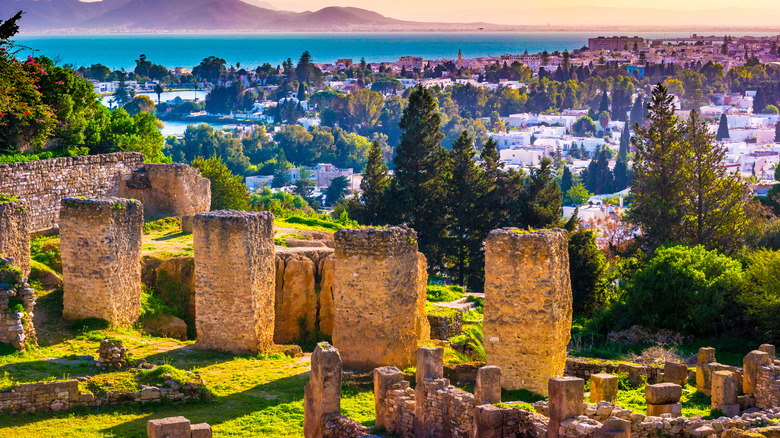Wander through the blue and white streets of Sidi Bou Saïd
Beaches at Sidi Bou Saïd vary from rocky to sandy. Among the cliffs in the northern part of the Sidi Bou Saïd area is the scenic Rocky Beach Sidi Bou Saïd, but if you prefer beaches with fine sand, head south to Sidi Bou Saïd Beach near the harbor for views of the blue water. Further south on the coastline is Amilcar Beach. This area juxtaposes fine sand with surrounding green hills.
On the way to the beaches, allow yourself to get lost within Sidi Bou Saïd’s streets, which are filled with blue and white buildings similar to those of Greece or Morocco. Among the buildings are locally-owned shops, art galleries, and cafés. One of the notable blue and white buildings is the Dar El Annabi museum, which showcases Islamic architecture dating back to the 18th century. Sweeping views of the town, cliffs, and the Gulf of Tunis are found among these streets as well, especially from the City Panorama Platform and the Sidi Bou Saïd Lighthouse.
See Roman ruins around Carthage

The town of Sidi Bou Saïd is actually located within the historic suburb of Carthage, in the northeast of Tunis. This ancient city became a battleground between the Carthaginian and Roman empires, which both aimed to take over Sicily. The three wars, called the Punic Wars, occurred between 264 and 146 B.C.E., between the two empires. The Roman Republic prevailed, taking over Carthage, and even thousands of years later, Roman structures still stand. The Roman Theater of Carthage, Baths of Antoninus, and the Roman houses of Amilcar are among the notable sites leftover from Roman rule and are all walking distance from Amilcar Beach. Further inland is the Amphitheater of Carthage and Byrsa Hill (pictured above), both offering more ancient ruins.
Carthage and Sidi Bou Saïd are just around 7 miles (11 kilometers) away from the ports in Tunis, at which multiple ferries dock after sailing from coastal Italian cities such as Genova and Palermo. Tunisia’s Tunis-Goulette-Marsa Metro (TGM) railway system connects the Tunis Marine station near the docks with the Marsa Plage “La Marsa” station, stopping at Sidi Bou Saïd and Sidi Dhrif, also located in the Sidi Bou Saïd area. To get closer to the Roman ruins, depart the train at Carthage Hannibal station.

